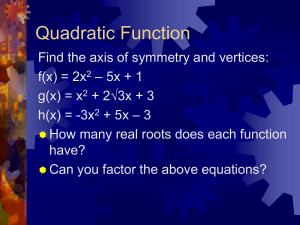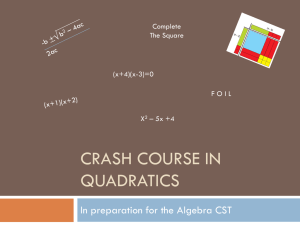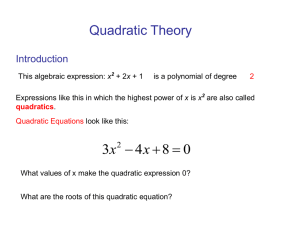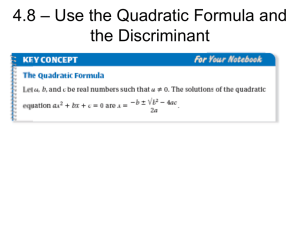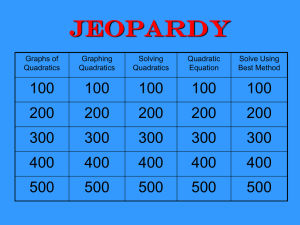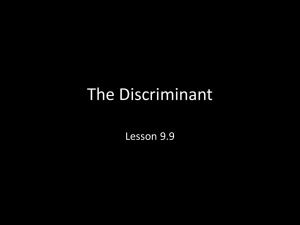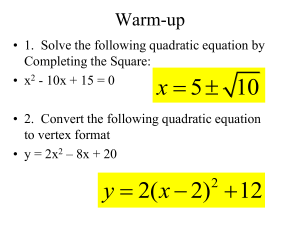The Quadratic Function
advertisement
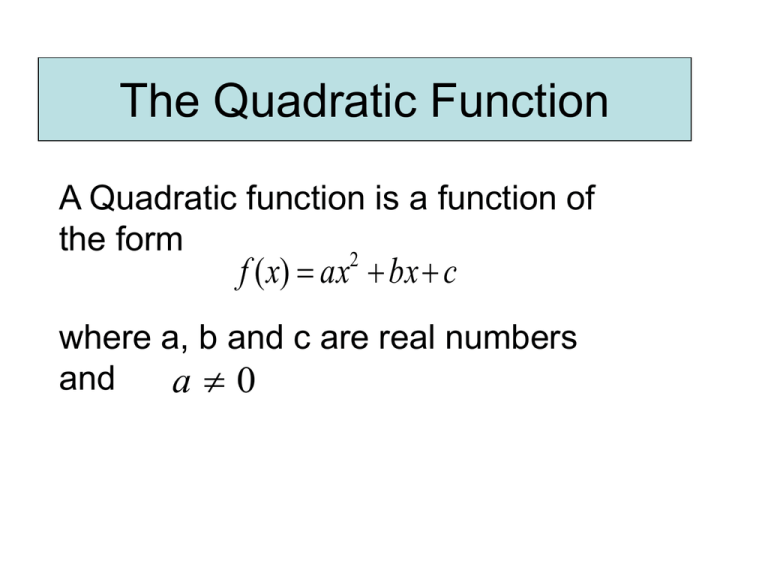
The Quadratic Function A Quadratic function is a function of the form 2 f ( x) ax bx c where a, b and c are real numbers and a0 The Quadratic Equation A Quadratic equation is an equation equivalent of the form ax2 bx c 0 where a, b and c are real numbers and a 0 Examples of Quadratic Equations 5x 2 4 x 2 0 2x 2 x 2 x2 1 0 2 2 Second Degree Equation A Quadratic equation is also a Second Degree equation because the highest exponent is two. The Standard Form of a quadratic equation is ax2 bx c 0 • where a, b and c are real numbers and a 0 Zeros of a Quadratic Function The zeros of a quadratic function f ( x) ax2 bx c f ( x) x 2 x 12 is the solution of the equation f(x) = 0 Since x = 4 and x= -3 are solutions of 2 f ( x ) x x 12 are x = 4 and x= -3. the zeros of We note that f (4) 4 2 4 12 0 f (3) (3) 2 (3) 12 0 Methods for Solving Quadratic Equations Factoring Taking the square root Using the quadratic formula Completing the square The Quadratic Formula For any Quadratic equation ax2 bx c 0 in standard form The Quadratic formula is given by b b 2 4ac x 2a We have derived this equation in class The Discriminant The expression b 4ac 2 is called the discriminant of the quadratic equation The Discriminant • The Discriminant of a Quadratic Equation tells whether the quadractic equation has any real solutions • It also tells how many real zeros or xintercepts the equation has. The Discriminant Two distinct real solutions The quadratic equation has 2 distinct unequal real solutions if b 2 4ac 0 The Discriminant One distinct Solutions The quadratic equation has 1distinct or 2 multiply real solutions if b 2 4ac 0 • No real solutions The quadratic equation has two non real solutions if b 4ac 0 2 Application (Second degreee equation) • Page 143 #87 Side of square metal sheet =x Subtract 1 foot from each end of each side Result - new side is x – 2 Depth of box is the inch taken from the sides Area of bottom of box is (x – 2)(x – 2) Volume of box is (side) (side) (depth) Volume is (x – 2)(x – 2)(1) Since box is to hold 4 cubic feet Volume of box is 4 feet 2 V (x) = (x – 2)(x – 2)(1)= (x-2) = 4 Application • (Second degree equation) Page 142 #90 s(t ) 4.9t 20t • Height of Object • Initial height is 0, since the object is thrown from the ground. • When object is 15 meters above the ground, the height is 2 2 s(t ) 4.9t 20t 15 • Using the quadratic formula, we get t = .99 or t = 3 .09 Page 142 #90(cont.) • b. When the object strikes the ground the height is s(t ) 4.9t 2 20t 0 • Thus t = 0 or t = 4.08. Thus the object will strike the ground after 4.08 sec. • c. When the object is 100 meter above the ground, the height function is s(t ) 4.9t 2 20t 100 • There is no real solution so the object never reaches 100 meters. The Quadratic function • Opens up when a>o opens down a < 0 Vertex axis of symmetry


